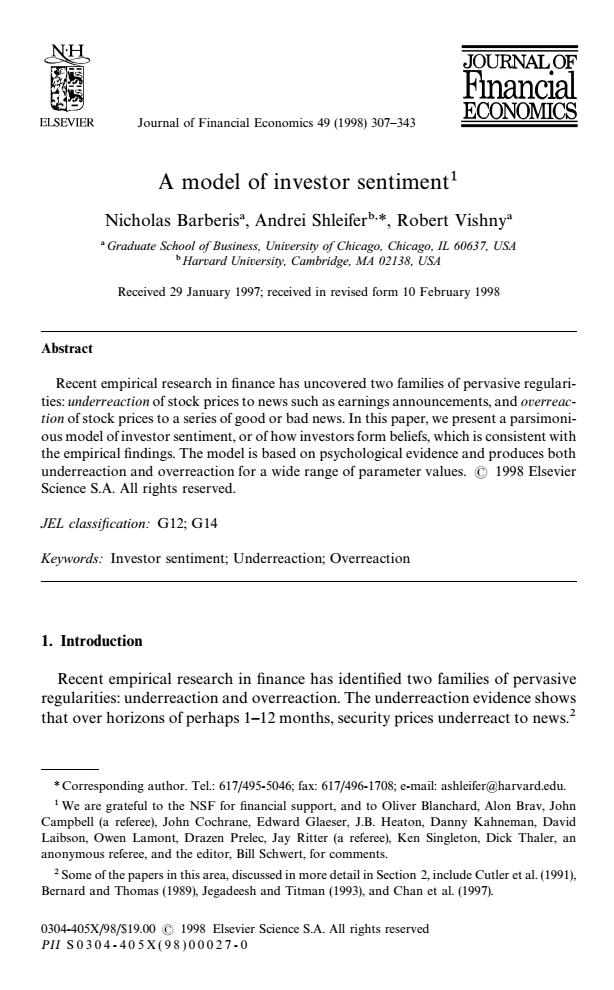正在加载图片...

N JOURNAL OF Financial ECONOMICS ELSEVIER Journal of Financial Economics 49(1998)307-343 A model of investor sentiment' Nicholas Barberis",Andrei Shleifer.*,Robert Vishny? Graduate School of Business,University of Chicago.Chicago.IL 60637.USA Harvard University.Cambridge,MA 02138.USA Received 29 January 1997;received in revised form 10 February 1998 Abstract Recent empirical research in finance has uncovered two families of pervasive regulari- ties:underreaction of stock prices to news such as earnings announcements,and overreac- tion of stock prices to a series of good or bad news.In this paper,we present a parsimoni- ous model of investor sentiment,or of how investors form beliefs,which is consistent with the empirical findings.The model is based on psychological evidence and produces both underreaction and overreaction for a wide range of parameter values.C 1998 Elsevier Science S.A.All rights reserved. JEL classification:G12;G14 Keywords:Investor sentiment;Underreaction;Overreaction 1.Introduction Recent empirical research in finance has identified two families of pervasive regularities:underreaction and overreaction.The underreaction evidence shows that over horizons of perhaps 1-12 months,security prices underreact to news.2 *Corresponding author.Tel:617/495-5046;fax:617/496-1708;e-mail:ashleifer@harvard.edu. We are grateful to the NSF for financial support,and to Oliver Blanchard,Alon Brav,John Campbell (a referee),John Cochrane,Edward Glaeser,J.B.Heaton,Danny Kahneman,David Laibson,Owen Lamont,Drazen Prelec,Jay Ritter (a referee),Ken Singleton,Dick Thaler,an anonymous referee,and the editor,Bill Schwert,for comments. 2Some of the papers in this area,discussed in more detail in Section 2,include Cutler et al.(1991), Bernard and Thomas(1989),Jegadeesh and Titman(1993),and Chan et al.(1997). 0304-405X/98/S19.00 C 1998 Elsevier Science S.A.All rights reserved P1S0304-405X(98)00027-0* Corresponding author. Tel.: 617/495-5046; fax: 617/496-1708; e-mail: ashleifer@harvard.edu. 1We are grateful to the NSF for financial support, and to Oliver Blanchard, Alon Brav, John Campbell (a referee), John Cochrane, Edward Glaeser, J.B. Heaton, Danny Kahneman, David Laibson, Owen Lamont, Drazen Prelec, Jay Ritter (a referee), Ken Singleton, Dick Thaler, an anonymous referee, and the editor, Bill Schwert, for comments. 2 Some of the papers in this area, discussed in more detail in Section 2, include Cutler et al. (1991), Bernard and Thomas (1989), Jegadeesh and Titman (1993), and Chan et al. (1997). Journal of Financial Economics 49 (1998) 307—343 A model of investor sentiment1 Nicholas Barberis!, Andrei Shleifer",*, Robert Vishny! ! Graduate School of Business, University of Chicago, Chicago, IL 60637, USA " Harvard University, Cambridge, MA 02138, USA Received 29 January 1997; received in revised form 10 February 1998 Abstract Recent empirical research in finance has uncovered two families of pervasive regularities: underreaction of stock prices to news such as earnings announcements, and overreaction of stock prices to a series of good or bad news. In this paper, we present a parsimonious model of investor sentiment, or of how investors form beliefs, which is consistent with the empirical findings. The model is based on psychological evidence and produces both underreaction and overreaction for a wide range of parameter values. ( 1998 Elsevier Science S.A. All rights reserved. JEL classification: G12; G14 Keywords: Investor sentiment; Underreaction; Overreaction 1. Introduction Recent empirical research in finance has identified two families of pervasive regularities: underreaction and overreaction. The underreaction evidence shows that over horizons of perhaps 1—12 months, security prices underreact to news.2 0304-405X/98/$19.00 ( 1998 Elsevier Science S.A. All rights reserved PII S0304-405X(98)00027-0